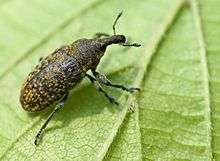Larinus planus
Larinus planus is an insect of the Curculionidae ("true" weevil) family. They are oval shaped, dark brown or black, and about 5-10 millimeters long.[1] While native to Europe, it is also common in North America. It feeds on floral buds, primarily of thistles, with the larvae stage being the most destructive to them. In North America, it has been used as a biocontrol agent.[2] It is also known as Larinus carlinae.[3][4]
| Larinus planus | |
|---|---|
 | |
| Scientific classification | |
| Kingdom: | |
| Phylum: | |
| Class: | |
| Order: | |
| Family: | |
| Subfamily: | |
| Genus: | |
| Species: | L. planus |
| Binomial name | |
| Larinus planus (Fabricius, 1792) | |
Description
The adult weevil is mostly dark brown or black, but has red-brown antennae. It is about 5-10 millimeters long and oval shaped. The wing covers have light colored mottled hairs on them and appear pock-marked. The nose is long and narrow, with a pronounced curvature.[5][6]
The eggs are black and appear the size of a "pin-prick." Once hatched, the larva has a segmented white body with a brown head, and is "C" shaped.[1]
Distribution
This weevil is indigenous to southwest England, as well as Central and Eastern Europe.[5][1]
It was accidentally introduced to Canada and the United States in the 1960s. The first published record is from Maryland in 1971.[7] It is now widespread throughout North America.
Biology
Adults emerge in the spring, and begin feeding on thistle buds. They require buds ranging in size from 5-7mm. The insects mate when the temperature is at least 22 °C (72 °F), which is usually about 14-16 days after they emerge. The female deposits a single egg in each floral bud, and then seals it. After hatching, the larva feeds on the floral bud it is hatched in. In doing so, it destroys about 95% of the seed contents. Another brood of adults emerges in late Autumn. These adults spend the winter in plant litter, to emerge in the spring.[1]
Larinus planus prefers dryer ranges, but can also adapt to wetter locations. It does well in sunny areas with well drained soils.[1]
Use as Biocontrol Agent
In Canada, it has been used as an agent of biological pest control against the noxious weed Canada thistle (Cirsium arvense). It was subsequently evaluated in the United States as a biocontrol agent and distributed across a range of the Great Plains in the western United States.[8][9]
In 2000, it was found feeding on Cirsium undulatum var. tracyi, a sparsely distributed thistle native to western Colorado and eastern Utah. Subsequent research determined that the weevil reduced seed production of the native thistle.[9] It has also been found to have an adverse effect on the native and threatened Cirsium pitcheri.[10]
References
- "Larinus planus". Ministry of Forests, Lands, and Natural Resource Operations. Province of British Columbia, Ministry of Forests. 17 May 2007. Archived from the original on 30 January 2019. Retrieved 30 January 2019.
- Operational Field Guide to the Propagation and Establishment of the Bioagent Larinus Planus (PDF). Province of British Columbia, Ministry of Forests. May 2001. Archived from the original (PDF) on 2018-11-13. Retrieved 2019-01-30.
- "Larinus planus (Fabricius, 1792)". Natural History Museum. The Trustees of The Natural History Museum, London. Retrieved 30 January 2019.
- "Larinus planus". Plant Parasites of Europe. W.N. Ellis, Amsterdam, The Netherlands. Retrieved 30 January 2019.
- "Larinus planus - Felthåndbogen". Danmarks Fugle og Natur. Retrieved 30 January 2019.
- "Larinus planus". Integrated Weed Control Project. Washington State University. Retrieved 30 January 2019.
- White, J. C. 1972. A European weevil, Larinus carolinae Oliver, collected in Maryland. Cooperative Economic Insect Report 22:418.
- Coombs, Eric; Clark, Janet; Piper, Gary; Cofrancesco, Alfred (2004). Biological Control of Invasive Plants in the United States. Oregon State University Press. ISBN 978-0-87071-029-2.
- Louda, Svaa M.; O'Brien, Charles W. (June 2002). "Unexpected Ecological Effects of Distributing the Exotic Weevil, Larinus planus (F.), for the Biological Control of Canada Thistle" (PDF). Conservation Biology. 16 (3): 717–727. doi:10.1046/j.1523-1739.2002.00541.x.
- Havens, Kayri; Jolls, Claudia L.; Marik, Julie E.; Vitt, Pati; McEachern, A. Kathryn; Kind, Darcy (October 2012). "Effects of a non-native biocontrol weevil, Larinus planus, and other emerging threats on populations of the federally threatened Pitcher's thistle, Cirsium pitcheri". Biological Conservation. 155: 202–211. doi:10.1016/j.biocon.2012.06.010.